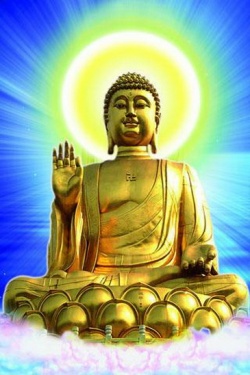Difference between revisions of "Two obscurations"
Jump to navigation
Jump to search
| Line 1: | Line 1: | ||
[[File:5835148.jpg|thumb|250px|]] | [[File:5835148.jpg|thumb|250px|]] | ||
| − | '''[[Two obscurations]]''' (Tib. {{BigTibetan|[[སྒྲིབ་པ་གཉིས་]]}}, ''[[dribpa nyi]]''; Wyl. ''[[sgrib pa gnyis]]'') — [[Emotional obscurations|emotional]] and [[cognitive obscurations]]. | + | '''[[Two obscurations]]''' (Tib. {{BigTibetan|[[སྒྲིབ་པ་གཉིས་]]}}, ''[[dribpa nyi]]''; [[Wyl.]] ''[[sgrib pa gnyis]]'') — [[Emotional obscurations|emotional]] and [[cognitive obscurations]]. |
| − | *'''[[Emotional obscurations]]''' are defined according to their essence, cause and function. | + | *'''[[Emotional obscurations]]''' are defined according to their [[essence]], [[cause]] and function. |
| − | In '''essence''', they are the opposite of the [[six paramitas]], as described in the ''[[Gyü Lama]]'': | + | In '''[[essence]]''', they are the opposite of the [[six paramitas]], as described in the ''[[Gyü Lama]]'': |
| − | :"Thoughts such as avarice and so on,<br> | + | :"[[Thoughts]] such as [[avarice]] and so on,<br> |
:These are the [[emotional obscurations]]."<br> | :These are the [[emotional obscurations]]."<br> | ||
| − | Their '''cause''' is grasping at a personal ego, or the | + | Their '''[[cause]]''' is [[grasping]] at a personal [[ego]], or the “[[self of the individual]]”. |
| − | They '''function''' to prevent liberation from [[samsara]]. | + | They '''function''' to prevent [[liberation]] from [[samsara]]. |
| − | *'''[[Cognitive obscurations]]''' are also defined according to their essence, cause and function. | + | *'''[[Cognitive obscurations]]''' are also defined according to their [[essence]], [[cause]] and function. |
| − | In '''essence''', they are thoughts that involve the three conceptual | + | In '''[[essence]]''', they are [[thoughts]] that involve the three {{Wiki|conceptual}} ‘[[spheres]]’ of [[subject]], [[object]] and [[action]]. The ''[[Gyü Lama]]'' says: |
| − | :"Thoughts that involve the three spheres,<br> | + | :"[[Thoughts]] that involve the [[three spheres]],<br> |
:These are the [[cognitive obscurations]]."<br> | :These are the [[cognitive obscurations]]."<br> | ||
| − | Their '''cause''' is grasping at phenomena as truly existent, or, in other words, the | + | Their '''[[cause]]''' is [[grasping]] at [[phenomena]] as [[truly existent]], or, in other words, the “[[self]] of [[phenomena]]”. |
Their '''function''' is to prevent complete [[enlightenment]]. | Their '''function''' is to prevent complete [[enlightenment]]. | ||
Revision as of 00:38, 30 September 2015
Two obscurations (Tib. སྒྲིབ་པ་གཉིས་, dribpa nyi; Wyl. sgrib pa gnyis) — emotional and cognitive obscurations.
- Emotional obscurations are defined according to their essence, cause and function.
In essence, they are the opposite of the six paramitas, as described in the Gyü Lama:
- "Thoughts such as avarice and so on,
- These are the emotional obscurations."
Their cause is grasping at a personal ego, or the “self of the individual”.
They function to prevent liberation from samsara.
- Cognitive obscurations are also defined according to their essence, cause and function.
In essence, they are thoughts that involve the three conceptual ‘spheres’ of subject, object and action. The Gyü Lama says:
- "Thoughts that involve the three spheres,
- These are the cognitive obscurations."
Their cause is grasping at phenomena as truly existent, or, in other words, the “self of phenomena”.
Their function is to prevent complete enlightenment.
